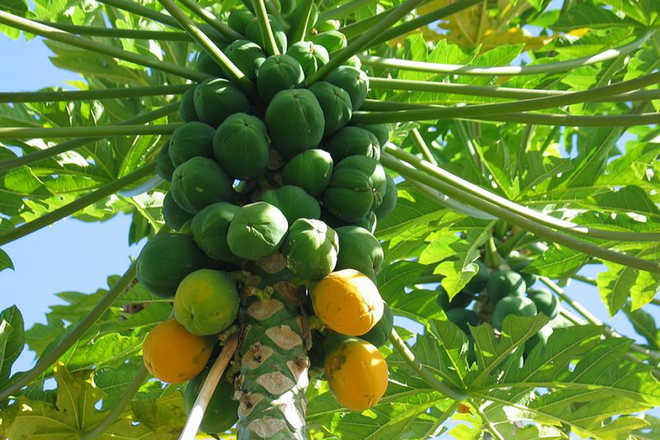Amarjeet Singh Batth
In cities where home garden space is limited, some fruit trees merge quite well with the landscape of the garden to give a uniform look with ornamental plants. Fruit trees not only add foliage elegance but also provide nutritional value.
Rainy season is the most appropriate time to grow fruit-giving plants. In fact, there are two planting season in this region for evergreen fruits trees — the first is Feburary-March and other is August-September.
Fruit trees grown in this season are pomegranates, kumquat, guava, lime (Nimbu-Bara massi and Kagzi nimbu), sweet orange (Malta), grape fruit, mango and loquat. The deciduous fruit plants are planted during their dormant period in December-January. These include, peach, plum, pear, phalsa, and grapes. Grapes can be planted even up to mid-February.
Some fruit tress such as ‘litchi’, ‘chikoo’ and mango grow well close to the foothill areas only. Fruit trees like papaya and banana will not blend with ornamental plants and should be planted in kitchen garden only.
Selection of space
The first and prime concern is the space available in the garden. Unlike like ornamental plants which can be planted even outside or around the periphery wall, the fruit trees should ideally be planted within the bundaries where these can be maintained properly. The space inside the garden should be sufficient enough to accommodate a fully-grown fruit tree. Do not try to cramp different varieties of fruit trees.
Once a fruit tree is planted, you should be well aware of the round- the-year horticultural operations.
Fruit trees require intensive care in comparison to ornamental plants. That’s why you should think of planting easy-to-grow fruit plants.
Finally, the source of fruit tree saplings must be authentic and varieties should be known to the grower. Go only for the varieties recommended by agricultural universities, horticultural department and source the same from reputed nurseries. It’s a long waiting period to draw the fruit for which you render labour and care.
PIT PREPARATION
Dig a pit 3” x 3’ feet deep and wide preferably during summers to disinfect the soil by exposure to sunlight. Keep the top half of the soil on one side and bottom half on the other. Mix farm yard manure on the top soil and mix it thoroughly. Refill the pit by mixing Chlorpyriphos 20 EC five ml dissolved in one liter of water a few days before planting. This will help settling the soil and take care of termites and white ants.
choice of plants
Consider a fruit plant which is of medium height, free from diseases and insect pests. In case of grafted plants the bud union should be smooth and remove the tying material. Be careful while transporting and ensure the earth balls do not get broken.
Care after planting
Keep the plant in a good growing environment. Keep the soil moist and be vigilant for any diseases and pest attack. Protect the plants against vagaries of extreme summers and winters conditions. A periodic inspection of plant is desirable.
Pruning should be carried out immediately after the fruiting season to maintain the size, form and improved inner ventilation.
The removal of dead wood and dried wood is a continuous process to check the spread of diseases. The fruit trees are given a dose of farm yard manure once in Dec-Jan and then in July.
However, the application of fertilisers is different for different plants. The quantity of manure and fertiliser depends on the age of the fruit tree.
Fly traps as suggested for fruit plants are:
Guava: First week of July
Kinnow: Second week of August
Mango: Third week of May
Pear: First week of June
Peach: First week of May
Plum: Second week of April
Growing Tips
Citrus: These plants are sensitive to extreme cold weather and high temperature, the foliage gets damaged and the fruit is affected. Pruning is done after the fruit harvest during late winters. Citrus plant faces zinc deficiency. Control also for pre harvest fruit drop.
Mango: Rainfall during flowering, high speed winds affecting pollination and hot summer wind causing fruit drop are the natural factors affecting fruit yield. Mango is susceptible to fruit drop in the last and first week of May. ‘Amarpali’ variety is small in size and can easily find space in a small garden space.
Guava: A hardy and popular fruit tree of this region bears fruit twice a year. However, winter fruit is superior in quality. Training improves plant frame work, fruit yield and quality. Remove intercrossing branches, basal and side suckers. A light pruning on tip encourage new shoot and can control the fruit timing. Farm yard manure in May and second dose in Sept -Oct moderate irrigation during winters and fortnight irrigation in summers is benificary.
Pomegranate: This tree requires rich and wet soil. Plant sheds leaves during extreme winters. Pruning is important to remove unwanted, crisscross, dead, diseased branches and basal growth. A dose of farm yard manure in December and light irrigation in winters and fortnightly irrigation during summers is desirable.
Unlock Exclusive Insights with The Tribune Premium
Take your experience further with Premium access.
Thought-provoking Opinions, Expert Analysis, In-depth Insights and other Member Only Benefits
Already a Member? Sign In Now










